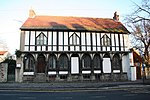Tickhill Friary
Monasteries in South YorkshireUnited Kingdom Christian monastery stubsYorkshire building and structure stubs
Tickhill Friary was an Augustinian friary in Tickhill, South Yorkshire, England. John Clarel, a canon of Southwell, founded it about 1260. It was dissolved in 1530. The remains are a Grade II* listed monument. The 14th century buildings were converted into dwellings in the 17th century, extensions followed in the 19th century. Until 1538, the Fitzwilliam tomb was located in the friary church, but was then moved into the parish church.
Excerpt from the Wikipedia article Tickhill Friary (License: CC BY-SA 3.0, Authors).Tickhill Friary
Rotherham Road, Doncaster Tickhill
Geographical coordinates (GPS) Address Nearby Places Show on map
Geographical coordinates (GPS)
| Latitude | Longitude |
|---|---|
| N 53.428333333333 ° | E -1.1195833333333 ° |
Address
Rotherham Road
Rotherham Road
DN11 9PF Doncaster, Tickhill
England, United Kingdom
Open on Google Maps






